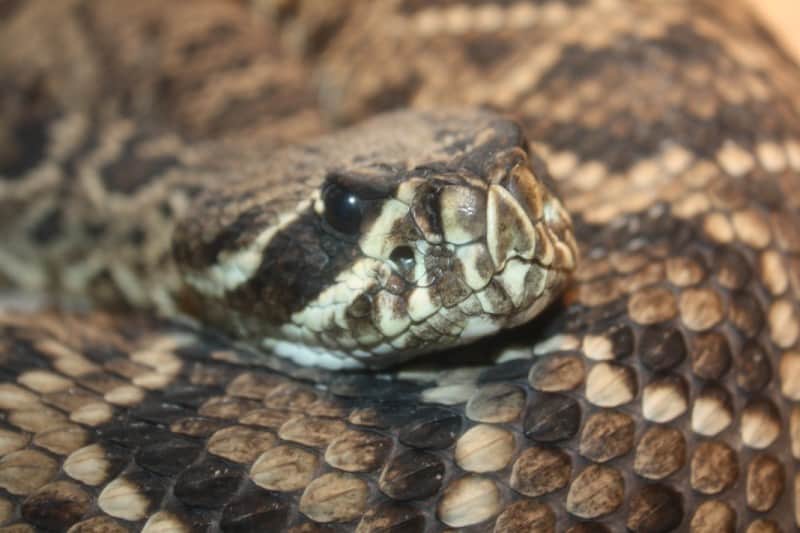
Eastern Diamondback Rattlesnake Facts
- Notably, the name of Eastern Diamondback Rattlesnake applies to a reptile that’s a highly venomous species of pit viper. Among professionals, such as researchers, though, its more frequently known by its technical name of the Crotalus adamanteus.
- It received that name due to the work of the respected French naturalist, Ambroise Marie François Joseph Palisot. He made the first formal recogntion of the reptile as a separate and distinct species. This noteworthy action he accomplished in 1799.
- This dangerous but magnificent rattlesnake also holds another impressive status. That’s because it ranks as the heaviest venomous snake on two continents. Despite its great weight, however, the animal does not qualify as the longest of them.
- For a variety of reasons, the IUCN currently lists it as a species of Least Concern on its Red List. This status currently remains under review, however. This reconsideration occurs due to ongoing changes in conditions within the range of the snake.
- Estimates place its population at only 3% of what it once was. Habitat loss and highway mortality, coupled with a low reproductive rate form the primary factors in its decline. Climate change may soon threaten the Eastern Diamondback Rattlesnake, as well.
Related Articles
Eastern Diamondback Rattlesnake Physical Description
The amazing creation of nature and evolution named the Eastern Diamondback Rattlesnake easily constitutes a physically imposing reptile. It holds this claim due to a very specific reason, though. That’s due to its sheer massiveness, for a venomous reptile.
Variations in size between individuals do sometimes,occur, however. This holds true partly due to the fact that this amazing creature displays a slight degree of the physiological characteristic of sexual dimorphism. In this, it’s like most of its relatives, though.
In its case, this principle manifests in terms of overall size. The male typically attains a slightly greater length and weight than the female. The difference remains quite small, though. Due to this, the two genders are usually considered to be of the same size.
A typical length for this incredible reptile thus equals roughly 5.5 ft (1.7 m). The typical adult generally weighs about 10 lb (4.5 kg). Yet, exceptional specimens occasionally reach lengths equaling as much as 7.8 ft (2.4 m). Most of the exceptional-sized individuals are male.
The Eastern Diamondback Rattlesnake also presents a striking image in color pattern. That’s because this typically consists of shades of brown, yellow, gray, and olive. This pattern develops overlaid with a series of 24-35 black or dark brown diamond shapes.
- Kingdom: Animalia
- Phylum: Chordata
- Class: Reptilia
- Order: Squamata
- Family: Viperidae
- Genus: Crotalus
- Species: C. adamanteus
Eastern Diamondback Rattlesnake Distribution and Ecology
Unfortunately for those who appreciate Nature, the Eastern Diamondback Rattlesnake evolved as endemic to a very limited territorial range. This native zone of habitation only includes the southeastern United States. Even there, it only appears in a limited area, though.
More specifically, due to these limitations, its natural range only extends along the coastal plain. More specifically, that runs from eastern North Carolina to southeastern Louisiana. The snake further inhabits some portions of the range in greater numbers than others.
Due to this natural tendency, the increasingly rare animal appears to be most numerous in the states of Alabama and Georgia. Unfortunately for those who love Nature, the reptile’s now offically considered to be extinct in the states of North Carolina and Louisiana.
It’s best known for its relative toxicity. A typical bite produces 3-4 times the amount of venom needed to kill an average human. Antivenom is available in most medical facilities throughout its range, however. Therefore, attacks usually only become fatal if untreated.
The dangerous but impressive animal also remains quite adaptable in character. In point of fact, it frequently shows that it will inhabit a wide range of habitat types. These regions include pine forests, sandhills, coastal hammocks, and most types of swampy areas.
The Eastern Diamondback Rattlesnake also displays yet another distinctive characteristic. This intriguing animal typically resides within burrows previously excavated by other animals. From there, it forages for prey, mainly consisting of smaller animals.
Species Sharing Its Range
Check out our other articles on 4 Stunning South American Woody Shrubs, Tawny Frogmouth, Ebor Falls, Hawaiian White Hibiscus, Chilean Dolphin, Hibiscus Harlequin Bug, Komodo Dragon
